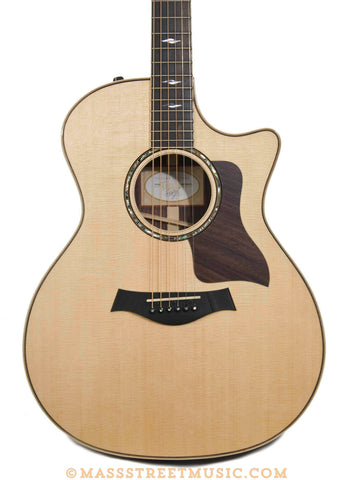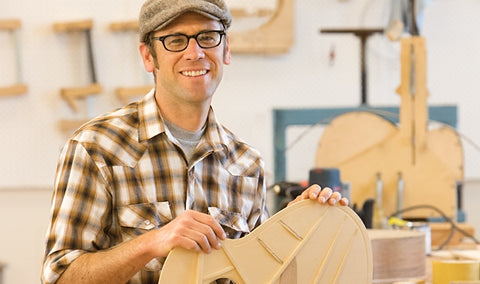 Taylor Guitars’ Master Guitar Designer Andy Powers joined Taylor in 2012 after spending years creating his own line of instruments. He’s been Bob Taylor’s right hand man ever since Bob invited him on board, saying Andy would have the opportunity “to make a significant impact on the future of good guitars” – and he’s done just that. His introduction of the Grand Orchestra body size in 2013 made for an exceptional sounding instrument shape that strummers and pickers could easily agree on. Always one to embrace change, Bob Taylor recently asked Andy to take a look at Bob’s first series, the 800 line, to see if there were any opportunities for advancement of the already popular series. Andy created a new bracing system, used hide and fish glue, and thinned the finish by half, among other things, resulting in even better sounding guitars – very fitting as the El Cajon, California guitar company celebrates its 40th Anniversary. Andy’s design and tonal insights and extensive luthier experience have fit perfectly with Taylor’s adventurous design spirit and quest for perfection. Before his innovations at Taylor, Andy not only built his own beautiful line of instruments, but also made a few surfboards – apparently you can find him on the waves as much as in the workshop.
Taylor Guitars’ Master Guitar Designer Andy Powers joined Taylor in 2012 after spending years creating his own line of instruments. He’s been Bob Taylor’s right hand man ever since Bob invited him on board, saying Andy would have the opportunity “to make a significant impact on the future of good guitars” – and he’s done just that. His introduction of the Grand Orchestra body size in 2013 made for an exceptional sounding instrument shape that strummers and pickers could easily agree on. Always one to embrace change, Bob Taylor recently asked Andy to take a look at Bob’s first series, the 800 line, to see if there were any opportunities for advancement of the already popular series. Andy created a new bracing system, used hide and fish glue, and thinned the finish by half, among other things, resulting in even better sounding guitars – very fitting as the El Cajon, California guitar company celebrates its 40th Anniversary. Andy’s design and tonal insights and extensive luthier experience have fit perfectly with Taylor’s adventurous design spirit and quest for perfection. Before his innovations at Taylor, Andy not only built his own beautiful line of instruments, but also made a few surfboards – apparently you can find him on the waves as much as in the workshop.
He was kind enough to take time out for a short email interview, in honor of our month long Taylor Guitars celebration. The questions came from the entire Mass Street Music staff:
MSM: Allowing for variances in the models, do you think there a quintessential Taylor sound?
Andy: Yes – the very curves of our guitars have a very unique family resemblance visually, and lend a family resemblance sonically. Significant changes can be made by altering brace patterns and profiles, wood thicknesses, etc. That said, there is a signature sound trait that runs in the Taylor family; it is often described as clear and balanced, or articulate, but more than anything, it is a flattering sound. Players have a tendency to get good sounds really easily out of these guitars, and consequently, end up making great music.
MSM: What did the design changes on the 800 series do for the sound overall? One of our luthiers in particular was curious about the inclusion of the fish glue – we’re of course familiar with hide glue, but not so much with the fish…
Andy: Overall, these became more dynamic instruments. Although each has unique strengths, I was looking to increase the overall volume where possible, strengthen the sustain, and embolden the projection, while giving each design a more consistent response over the whole register.
The fish glue is interesting. Another guitar maker friend turned me on to it. I’ve been using the Milligan and Higgins hot hide glue for a long time and love it, but the fish glue has some different working properties that made it useful specifically for gluing braces. In a nutshell, the stuff is *sticky*. I mean, really, really sticky. As it dries, it becomes almost indistinguishable from the M and H glue I like – the protein chain is really similar and the glues function the same. But extra stick is helpful for gluing braces.
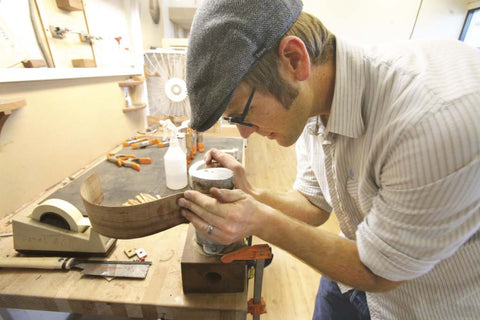
MSM: I read that you approached the design changes of the 800 series individually, looking at each model – but how did you begin overall with approaching redesigning Bob Taylor’s first model series line? What things did you keep at the forefront of your mind in process?
Andy: Don’t ruin a good thing. That sounds funny to say, but it is the truth – there is a lot to like about 800 series; they are versatile and consistent guitars. That is a good place to start from, and was a good thing to keep in mind as I redesigned these. I wanted to uphold everything we as guitar players loved about the 800s while improving the areas I felt could benefit.
MSM: Did you have to pitch or convince Bob on anything about the new designs, the glues, the bracing, etc or were you given free reign?
Andy: I have latitude to make what I dream up and discover. That is balanced by Bob and I having a real close working relationship; we bounce ideas back and forth and sweat over details to distill what really is the best guitar for us to make.
MSM: Did the design changes have any impact on manufacturing or change anything significantly on the manufacturing end of things?
Andy: Oh yes. These are a lot of details that go into these guitars that are new, and frankly, challenging to make. I’m proud of what we’ve been able to accomplish with these guitars.
MSM: On average, how many prototypes did you build of each before you settled on the final designs?
Andy: For the functional aspects, it is hard to say, because each reflects a state of refinement brought on by a whole lot of other guitars I’ve built. The aesthetic components had quite a few iterations of different ideas, but mostly, different versions of the finish while we worked out how we were going to try and make it so thin.
MSM: What is your favorite 800 series model and why?
Andy: It depends on the day and what I’ve listened to. The 814ce is a perennial favorite, because it always seems to be up for the music at hand-finger style, with a flat pick, jazz, anything goes. That said, I do really like the grand concert shapes.
The Taylor 814ce Acoustic Electric Guitar – newly redesigned by Andy Powers
MSM: After the success of your Grand Orchestra model shape which is great for strummers and finger style players alike, do you envision other new shapes down the pike?
Andy: Sure – there are always more guitars to make. If I finish making a great guitar, the next morning I come into the shop and think – right, let’s see if I can do a better one. Or one with a new personality, or…..Music is always growing, evolving, and being created. Instruments develop in tandem.
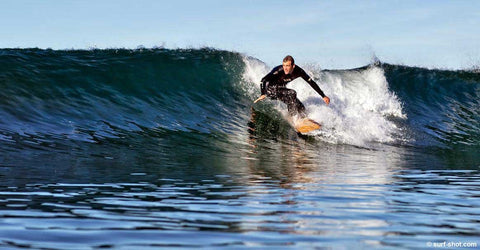
MSM: What is your favorite surf spot in the San Diego area? In the world?
Andy: I’d have to say Blacks in La Jolla. I grew up surfing beach breaks in north San Diego county, so I have an affinity for that sort of wave. I got into surfing Blacks because of the increased power and size, not to mention the quality. There is a submarine canyon there – think of it as a big cut in the continental shelf that acts like a magnifying glass focusing open ocean power at one stretch of beach. Plus it redirects some of its power at a slightly different angle creating these really well defined peaks; it’s really something else. When it’s good, it has got to be one of the most enjoyable waves in the world. I actually decided to go to college at UCSD specifically because of the close proximity to this spot. Often, I’ll end up enjoying the surf in Carlsbad as well; the Tamarack jetties are right down the street from my house, so close proximity makes that an easy enjoyable go-to spot as well.
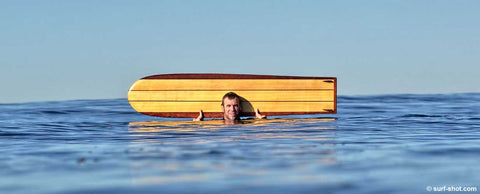
Photo: surf-shot.com
Don’t miss our all of our great Taylor Guitars events during May including the Taylor Road Show on Monday, May 12 at 6:30PM and our Taylor Guitars Shindig day-long celebration on Saturday, May 24, including performances from local performers, giveaways and more! Find out more on our Mass Street Events Page. You can check out all the Taylor Guitars available at Mass Street Music here.

